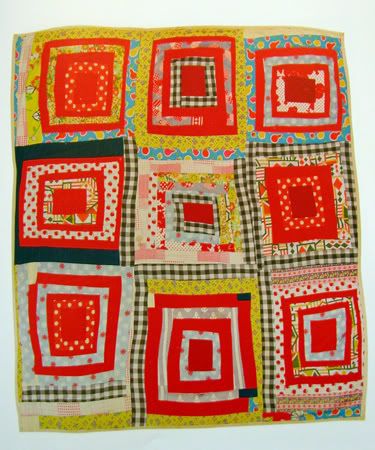 (This quilt was designed by Arlonzia Pettway in 1982. It's based on the "housetop" pattern and can be found in Gee's Bend: The Women and Their Quilts. Tinwood Books, 2002).
(This quilt was designed by Arlonzia Pettway in 1982. It's based on the "housetop" pattern and can be found in Gee's Bend: The Women and Their Quilts. Tinwood Books, 2002).
Yesterday, as part of her show's Martin Luther King Day celebrations, Oprah did a small feature on the town of Gee's Bend, Alabama (with some video of the town's famous quilters), where Dr. Martin Luther King Jr. gave a speech in 1965. During the 1960's, the small isolated black commmunity of Gee's Bend became involved in the Freedom Quilting Bee--a civil rights related campaign that provided an opportunity for African American women to preserve their quilting traditions by selling their handiwork to outsiders.
I was lucky to have the opportunity to examine the quilts of Gee's Bend several years ago for a professor who was writing a book on the history of cotton. It was incredible story about how a group of women were able to transform quilt making from a survival skill that helped their families through long winters into a viable and thriving business that significantly augmented their household incomes.
The isolation of the Gee's Bend community was a significant factor in preserving the aspects of African culture that made the Gee's Bend quilts unique. Many of their methods of quilt making had been preserved since the time when African Americans had first arrived in Alabama as slaves:
…the appliqué tradition that flourished in the American South was brought over
by slaves from Benin (formerly known as Dahomey), West Africa. In the Benin
tapestries, stories from oral tradition and history are illustrated with
appliquéd figures. Animals are used to symbolize kings or central figures of
proverbs or folktales. The influence of Benin appliqué tradition on the Bible
quilts of Harriet Powers, an ex-slave from Benin has been firmly established by
scholars, particularly in her technique and animal symbolism. Another intriguing
aspect of Harriet Powers’ quilts is the merging of Christian religious symbols
with the African cosmology of the Bakongo people. (Fry, 12).
The quilters of Gee's Bend often use much simpler designs than those described above, but they are still infused with vibrant colours (the quilters also make use of unusual materials, such as denim from blue jeans).
Sewing was a survival skill for the earlly members of the Freedom Quilting Bee. Nettie Pettway Young (a founding member) recalls:
Sewing is almost my heart. I just love to sew and quilt quilts with my mother.
When I was six years old I started helping her sew. I went on to making quilts
and learned how to make all the different quilts she knowed how to make:
Bricklayers, Monkey Wrenches, Grandmama’s Dream, Grandmother’s Choices, Coat of
Many Colors, Broken Stoves, Wild Geese Chases, Cross Cut Saw, Stars, Sweeps, and
Bear’s Paws. We growed up making those quilts. I don’t know why they spell out
from but we made ’em through our own parents. I guess she did learn from her
mother, ‘cause her mother was making quilts and quilting ‘em, too, when I knowed
my grandmother.
I growed up sewing. I used to make all my kids’ clothes. I
never bought clothes. I made the clothes(Callahan, 194).
The quilts of Gee's Bend became incredibly fashionable during the 1960s when Diana Vreeland of American Vogue began featuring them in photo layouts in her magazine(Callahan, 64). However, as the business acumen of the quilting bee members increased, it helped ensure that their co-op would survive long after quilts lost their trendy appeal. The quilts remain popular today and are often exhibited in fine art galleries.
Sources:
Callahan, Nancy. The Freedom Quilting Bee. Tuscaloosa, Alabama: University of Alabama Press, 1987.
Fry, Gladys-Marie. Stitched from the Past: Slave Quilts from the Ante-Bellum South. (New York: Dutton Studio Books, 1990).
The quilts of Gee's Bend are incredibly unique. To view more of these masterpieces, check out their
website.
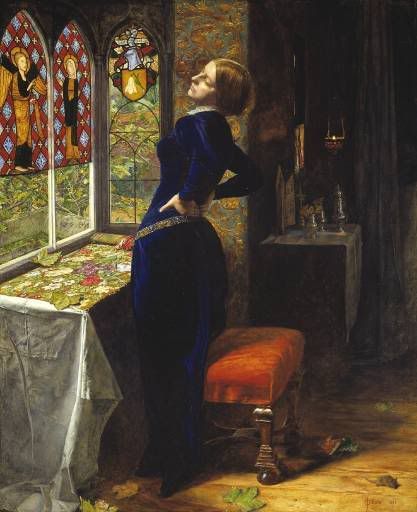

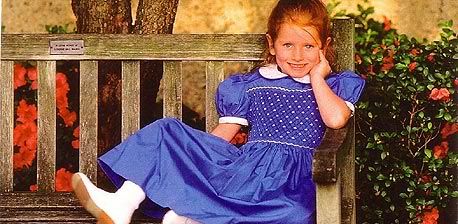
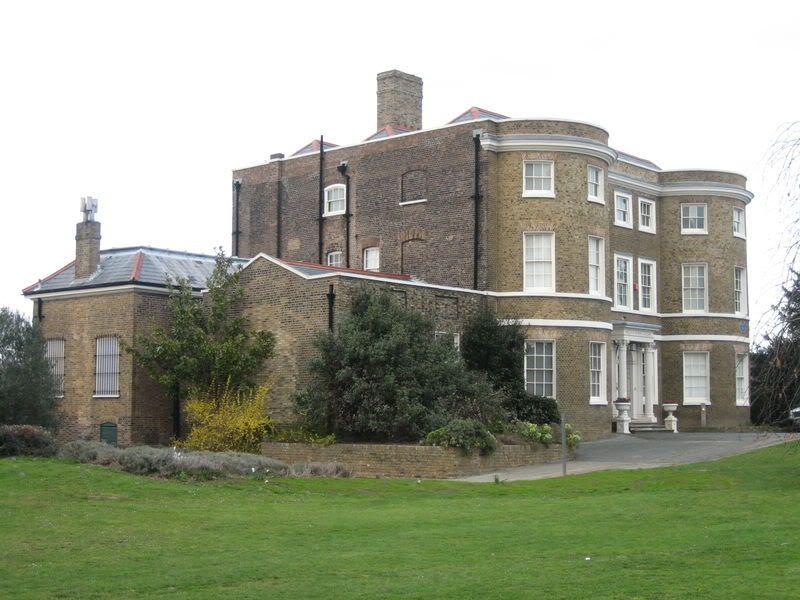
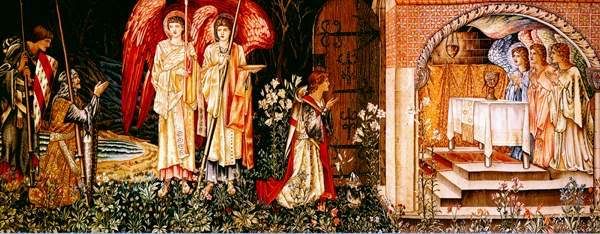

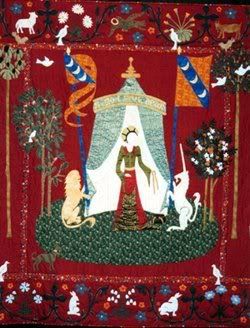
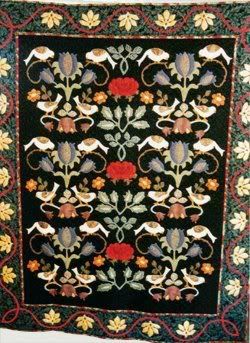
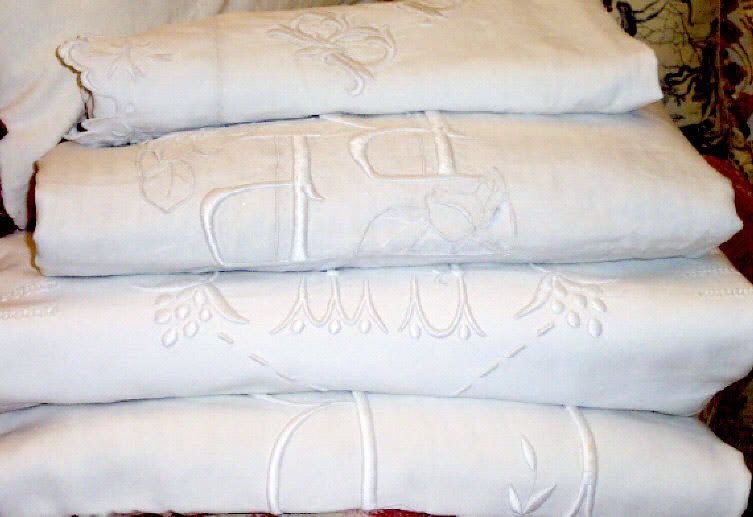



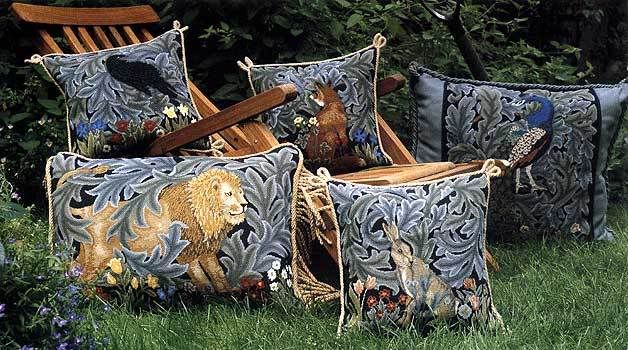 The Forest Tapestry, created in 1887 was designed by Morrs, Philip Webb and John Henry Dearle. It was later woven out of wool and silk on cotten warp in the Merton Abbey workshops by Morris and Co.'s three most senior weavers. It is believed that John Henry Dearle, Morris' most talented assistant and an expert in the art of natural dyes, created the floral details for the tapestry. The animals were drawn by Morris' friend (and designer of Red House), Philip Webb. Morris wrote the inscription that was written across the original: "The Beasts that be in woodland waste, now sit and see nor ride nor haste" (the verse was later published under the title "The Lion" and included in a volume of poetry by Morris entitled Poems by the Way (1891).
The Forest Tapestry, created in 1887 was designed by Morrs, Philip Webb and John Henry Dearle. It was later woven out of wool and silk on cotten warp in the Merton Abbey workshops by Morris and Co.'s three most senior weavers. It is believed that John Henry Dearle, Morris' most talented assistant and an expert in the art of natural dyes, created the floral details for the tapestry. The animals were drawn by Morris' friend (and designer of Red House), Philip Webb. Morris wrote the inscription that was written across the original: "The Beasts that be in woodland waste, now sit and see nor ride nor haste" (the verse was later published under the title "The Lion" and included in a volume of poetry by Morris entitled Poems by the Way (1891).


 What do you think? I think the variation of colours in this pattern are a bit more fun to work with than Sunflower.
What do you think? I think the variation of colours in this pattern are a bit more fun to work with than Sunflower.
